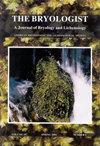Recent Literature on Bryophytes — 125(3)
IF 1.5
4区 生物学
Q4 PLANT SCIENCES
引用次数: 1
Abstract
incl. Vesicularia montagnei, Isopterygium sp., Fontinalis sp., Riccia rhenana and Riccardia sp.] Ye, J.-L., J.-Y. Ye, S. Luo, C. Chen, C.-F. Wen & Y.-Y. Xu. 2022. The complete chloroplast genome of Calohypnum plumiforme (Wilson) (Hypanceae, Bryophyta). Mitochondrial DNA Part B: Resources 7(3): 480–481. [doi: 10.1080/23802359.2021. 1996294; ‘‘The phylogenetic analysis suggested that C. plumiforme is sister to Calliergonella cuspidata.’’] Yi, Y.-J., J. Zhang, X.-X. Xiao & S. He. 2021. Delongia flavolimbata (S.He & Y.J.Yi) S.He & Y.J.Yi, an unusual species with elamellate laminae from China, newly combined in Polytrichaceae based on molecular data. Journal of Bryology 43(4): 313–320. [doi: 10. 1080/03736687.2021.2004358; with a key to the species of Delongia.] Yi, Z.-Q., L.-Q. Mu & Y. Jia. 2022. Notes on Glossadelphus M.Fleisch. (Hypnaceae, Bryophyta) in China. Phytotaxa 541(3): 225–239. [doi: 10.11646/PHYTOTAXA.541.3.2; synonymy: Myurella brevicosta 1⁄4 Bryocrumia vivicolor, Glossadelphus isopterygioides 1⁄4 Entodon obtusatus; lectotypes designated: Glossadelphus anomalus and G. falcatulus; new: Ectropothecium anomalum (Thér.) Z.Q.Yi & Y.Jia comb. nov., E. falcatulum (Broth.) Z.Q.Yi & Y.Jia comb. nov.] Yu, J., Y.-Q. Cai, Y.-X. Zhu, Y.-Y. Zeng, S. Dong, K.-X. Zhang, S.-B. Wang, L.-Z. Li, B. Goffinet, H. Liu & Y. Liu. 2022. Chromosome-level genome assemblies of two Hypnales (mosses) reveal high intergeneric synteny. Genome Biology and Evolution 14(2): evac020 [1–6]. [doi: 10.1093/gbe/evac020; ‘‘The chromosomes of E. seductrix and H. curvifolium are highly syntenic, suggests limited architectural shifts occurred following the rapid radiation of the Hypnales. We compared their genomic features to the model moss Physcomitrium patens. The hypnalean moss genomes lack signatures of recent wholegenome duplication.’’] Yusup, S., S. Sundberg, B.-B. Fan, S. Mamtimin & Z.-J. Bu. 2022. The response of spore germination of Sphagnum mosses to single and combined fire-related cues. Plants 11(4): 485 [1–13]. [doi: 10.3390/plants11040485.] Zaccara, S., J. Patiño, P. Convey, I. Vanetti & N. Cannone. 2020. Multiple colonization and dispersal events hide the early origin and induce a lack of genetic structure of the moss Bryum argenteum in Antarctica. Ecology and Evolution 10(16): 8959– 8975. [doi: 10.1002/ece3.6601.] Zander, R. H., G. M. Suárez & S. Jimenez. 2021. A new species of Acaulon Müll.Hal. (Pottiaceae, Bryophyta) from Argentina with apiculate capsules. Journal of Bryology 43(4): 384–386. [doi: 10. 1080/03736687.2021.2001625; new: Acaulon anomalum R.H.Zander, G.M.Suárez & M.S.Jimenez sp. nov.] Zhalov, H. Kh. & F. Abdı́rasulov. 2022. Taxonomic analysis of the brieflora [sic] of the Kulsay Basin (Zaaminsky Mountain-Forest State Reserve). Bulletin of the National University of Uzbekistan 3/1: 80–84. [In Tajik with English abstract.] Zhang, L., T.-H. Li, S.-Z. Su, H. Peng, S. Li, K. Li, L. Ji, Y.-Y. Xing, J.-C Zhang, X.-L. Du, M.-D. Bian, Y.-Y. Liao, Z.-M. Yang & Z.C. Zuo. 2022[2021]. Functions of COP1/SPA E3 ubiquitin ligase mediated by MpCRY in the liverwort Marchantia polymorpha under blue light. International Journal of Molecular Sciences 23: 158 [1–18]. [doi: 10.3390/ijms23010158.] Zhang, Y.-G., A. Mutailifu, Y. Zhang, H.-L. Yang & D.-Y. Zhang. 2021. Detection of abscisic acid and relative transcript Atwood et al.: Recent literature on bryophytes 499苔藓植物最新文献-125(3)
包括山灰蝶属、异翅目、方翅目、大黄Riccia和贲门Riccardia sp.。]叶,J.-L.,J.-Y.Ye,S.Luo,C.Chen,C.-F.Wen和Y.Y.Xu。2022.Calohypnum plumiforme(Wilson)(Hypanceae,Bryophyta)的完整叶绿体基因组。线粒体DNA B部分:资源7(3):480–481。[doi:10.1080/3802359.2021。1996294;''系统发育分析表明,羽化C.plumiforme是尖尾卡氏菌的姐妹易,张,肖,何。2021.Delongia flavorlimbata(S.He&Y.J.Yi)S.He&Y.J.Yi,一种来自中国的不寻常的elamellate薄层植物,根据分子数据在Polytrichoceae中新组合。苔藓学杂志43(4):313–320。[doi:10。1080/0736687.2021.2004358;有一把Delongia物种的钥匙。]易、穆、贾。2022.关于Glossadelphus M.Fleisch.(Hypnaceae,Bryophyta)在中国的注释。植物分类群541(3):225–239。[doi:10.11646/PHYTOTAXA.541.3.2;同义词:Myurella brevicota 1/4 Bryocrumia vivicolor,Glossadelphus isoptergioides 1/4 Entodon obtus;指定的选型:Glossadelphis anomalus和G.falcatulus;新:Ectroptothecium anomalum(Thér.)Z.Q.Yi和Y.Jia comb.nov.,E.falcatulum,王,李,高,刘,刘。2022。两种Hypnales(苔藓)的染色体水平基因组组装揭示了高属间同源性。基因组生物学与进化14(2):evac020[1-6]。[doi:10.1093/gbe/evac020;“E.troptrix和H.curifolium的染色体是高度同源的,这表明Hypnales的快速辐射后发生了有限的结构变化。我们将它们的基因组特征与模式苔藓Physcomitrium patens进行了比较。hypnalean苔藓基因组缺乏最近全基因组复制的特征。”Yusup,S.,S.Sundberg,B.-B.Fan,S。Mamtimin&Z.-J.Bu。2022.泥炭藓孢子萌发对单一和组合火灾相关线索的反应。植物11(4):485[1-13]。[doi:10.3390/plants11040485.]Zaccara,S.,J.Patiño,P.Convey,I.Vanetti&N.Cannon。2020.多重殖民化和扩散事件掩盖了南极银苔藓的早期起源,并导致其缺乏遗传结构。生态学与进化10(16):8959–8975。[doi:10.1002/ece3.6601.]赞德,R.H.,G.M.苏亚雷斯和S.希门尼斯。2021.一个新种Acaulon Müll.Hal.(Pottiacee,Bryophyta),来自阿根廷,具细尖胶囊。苔藓学杂志43(4):384–386。[doi:10。1080/0736687.2021.2001625;新:Acaulon anomalum R.H.Zander、G.M.Suárez和M.S.Jimenez sp.nov.]Zhalov、H.Kh.和F.Abdı́rasulov。2022.Kulsay盆地(Zaaminsky山森林国家保护区)brieflora的分类学分析[原文如此]。乌兹别克斯坦国立大学公报3/1:80-84。[塔吉克文,附英文摘要。]张,李,苏,彭,李,季,邢,张,杜,边,廖,杨,左。2022【2021】。MpCRY介导的COP1/SPA E3泛素连接酶在蓝光下对多晶苔草的作用。《国际分子科学杂志》23:158[1-18]。[doi:10.3390/ijms23010158]张,Y.G.,A.穆泰利夫,Y.张,H.-L.杨和D.-Y.张。2021.脱落酸和相对转录物的检测Atwood等人:苔藓植物的最新文献499
本文章由计算机程序翻译,如有差异,请以英文原文为准。
求助全文
约1分钟内获得全文
求助全文
来源期刊

Bryologist
生物-植物科学
CiteScore
2.40
自引率
11.10%
发文量
40
审稿时长
>12 weeks
期刊介绍:
The Bryologist is an international journal devoted to all aspects of bryology and lichenology, and we welcome reviews, research papers and short communications from all members of American Bryological and Lichenological Society (ABLS). We also publish lists of current literature, book reviews and news items about members and event. All back issues of the journal are maintained electronically. The first issue of The Bryologist was published in 1898, with the formation of the Society.
Author instructions are available from the journal website and the manuscript submission site, each of which is listed at the ABLS.org website.
All submissions to the journal are subject to at least two peer reviews, and both the reviews and the identities of reviewers are treated confidentially. Reviewers are asked to acknowledge possible conflicts of interest and to provide strictly objective assessments of the suitability and scholarly merit of the submissions under review.
 求助内容:
求助内容: 应助结果提醒方式:
应助结果提醒方式:


